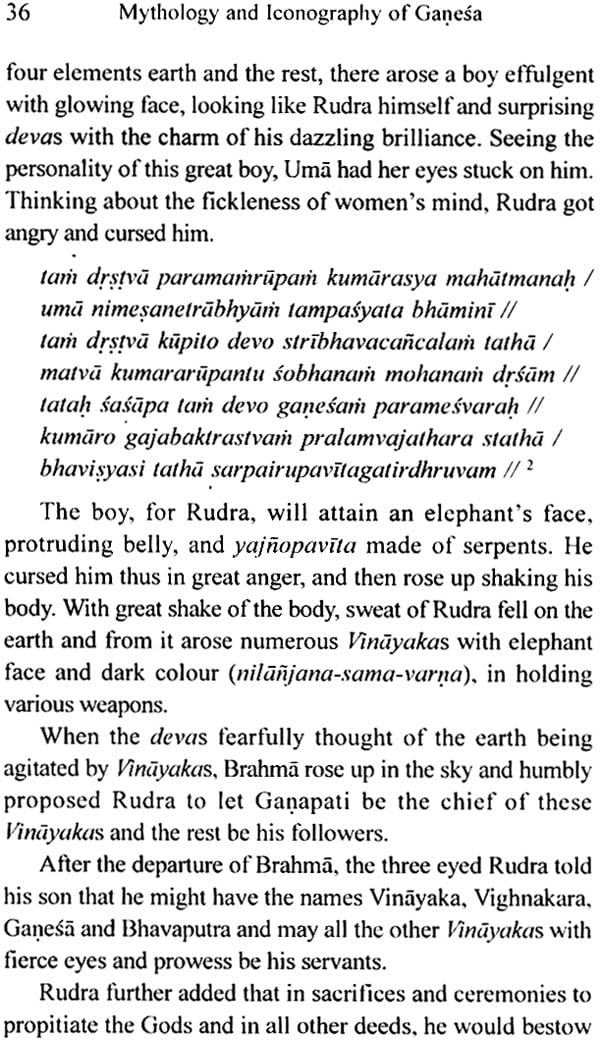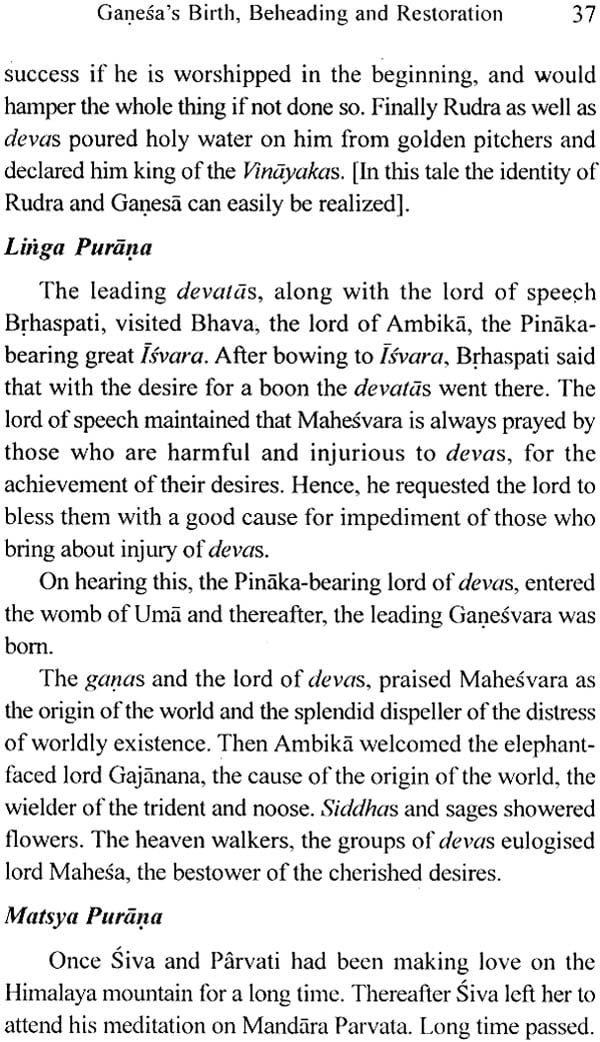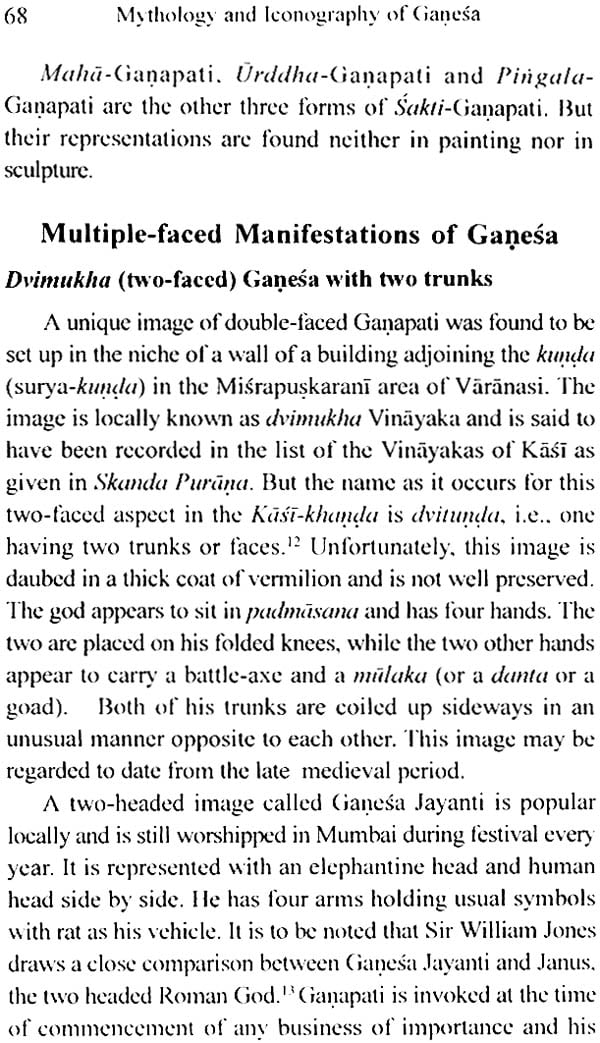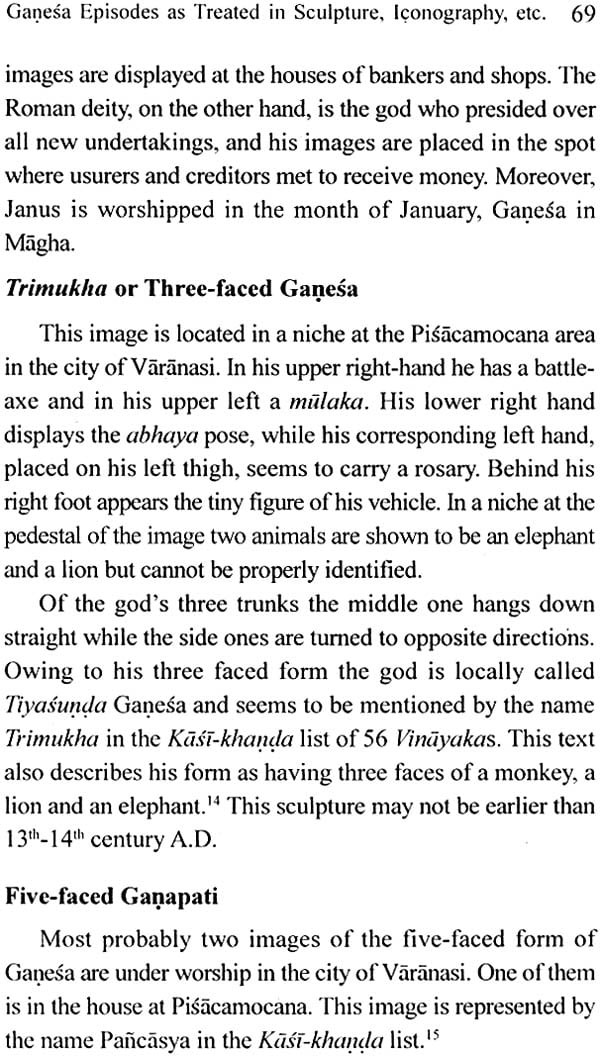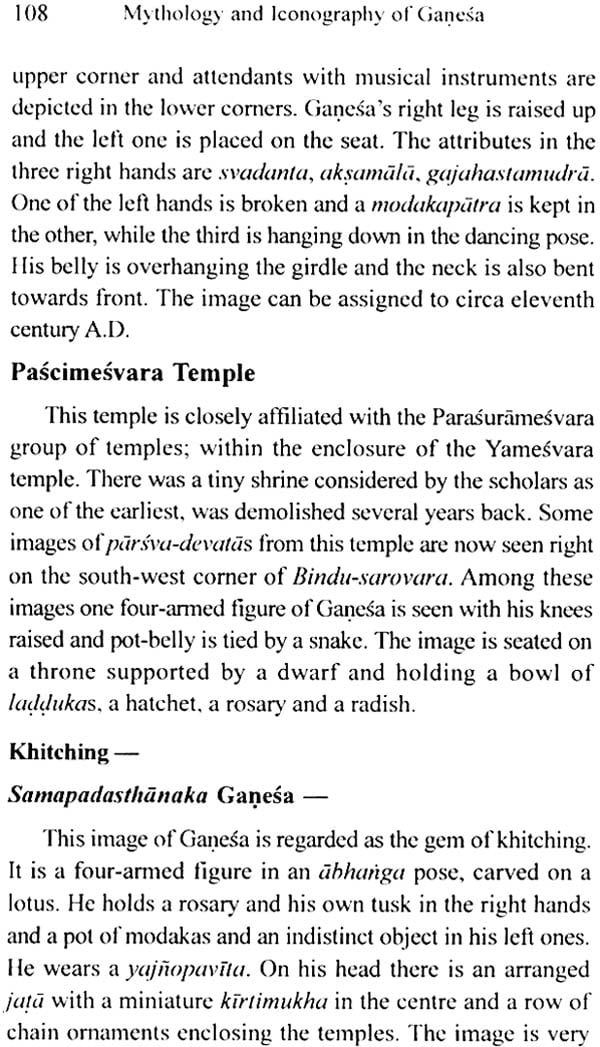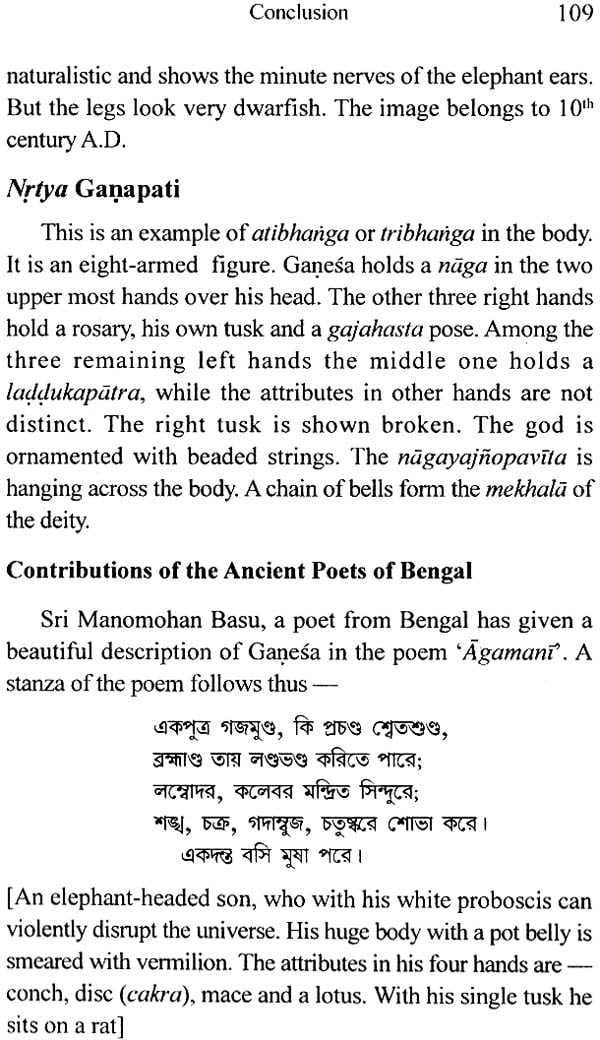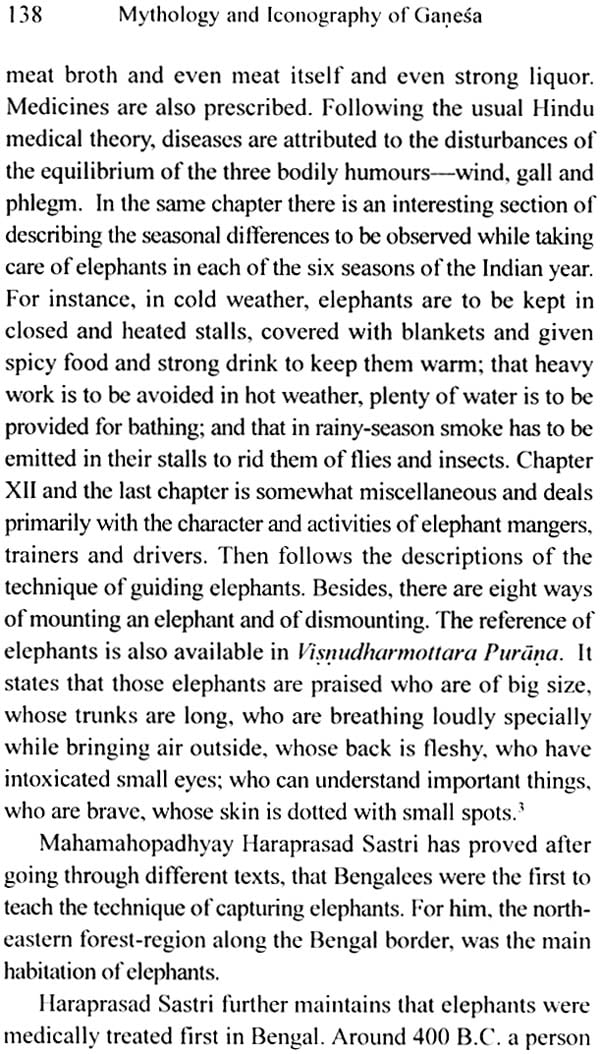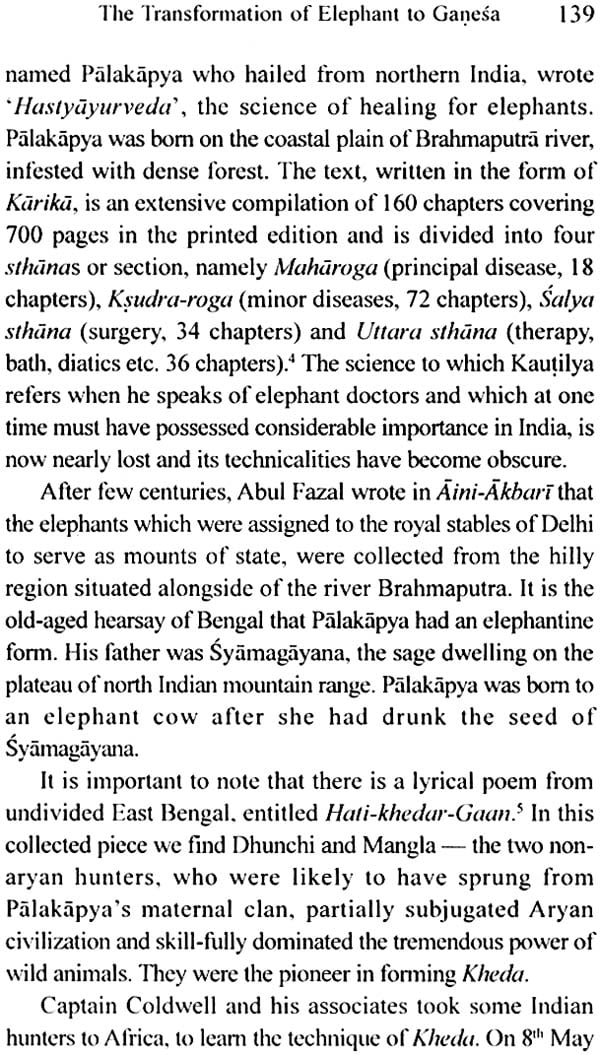
Mythology and Iconography of Ganesa
Book Specification
| Item Code: | NAF838 |
| Author: | Dr. Madhumita Datta |
| Publisher: | Ramakrishna Mission Institute of Culture |
| Language: | English |
| Edition: | 2012 |
| ISBN: | 9789381325193 |
| Pages: | 188 (24 Color Illustrations) |
| Cover: | Paperback |
| Other Details | 9.0 inch X 5.5 inch |
| Weight | 330 gm |
Book Description
The abstract philosophy, in order to be graspable, becomes concretized in the mythological gods and goddesses. Quite aptly, the rich spiritual tradition of India has an impressive pantheon. In this Hindu pantheon, Lord Ganesa occupies an adorable place. Indeed, the worship of Lord Ganesa ever remains an age-old religious tradition of India-this celestial child of Lord Siva and Devi Parvati being permanently enthroned in the hearts of countless devotees. Ganesh has transcended the barrier of Hinduism to be equally adored in Jainism and Buddhism too. In that sense, Ganesa is truly a deity of Indian pantheon.
This present book by Dr Madhumita Datta, Assistant Professor, Department of Philosophy, Behala College, is an attempt to trace the mythological roots of this important deity of Indian pantheon. Along with this central theme, a chapter on Iconography deals with the interpretations of the various images of Lord Ganesa. Also towards the end of this book, the topic on the cult of Ganesa across Bengal and surrounding areas promises to be quite informative. It is hoped that interested readers would find this book thought-provoking.
Among many deities worshipped by the Hindus, Ganapati or Ganesa is the most popular. It is not that he is considered to be superior to the great gods and goddesses but he has a special place in the affection of people and everybody pays homage to him at the commencement of an enterprise.
The word ‘Ganapati’ literally means the leader of the ganas. He is in turn associated with Rudra (Siva). He gradually achieved Brahmanical recognition and also obtained the recognition as the son of Siva and Parvati. It seems, therefore, that Ganesa is to be looked upon as a secondary rather than an original deity.
With regard to the Puranic accounts, the origin of Ganesa is very interesting but the different Puranas give different accounts. In some he is considered to have been born solely to Siva, in others solely to Parvati and in some other cases to both Siva and Parvati. The earliest reference to Ganesa is there in Aitareya Brahmana, where Ganapati is identified with Brahmanaspati or Brhaspati. When Vyasa composed the Mahabharata, he employed Ganesa as a scribe, who wrote according to the Vyasa’s dictation using his own tusk as a stylus. He is also held in the accounts of Brahmavaivarta Purana to be Krsna in another form
It is believed that Ganesa was originally a totem, a Dravidian deity worshipped by the aboriginal population of India, the worshipper of Sun. It is also suggested that on his cult-animal, the rat, Ganesa symbolized a Sun-god overcoming the animal, which in ancient mythology was a symbol of night. It is to be noted here that there is a form of Ganesa in Nepal called Surya-Ganapati. Others are of the opinion that he belonged originally to an animal cult, since his image is found in Hindu temples worshipped in company with the animal avataras.
During the tenth century Ganesa, under the name of Ganapati, became the most important deity of a mystic and powerful sect-the ganapatyas who established his worship to the exclusion of other Hindu gods. The non-sectarian temper of Ganesa-worship inspired freedom-fighter Bal Gangadhar Tilak to use Ganesa as an icon of concord. In the late nineteenth century, he initiated a community festival of Ganesa in Maharastra, deliberately designed to bring people of various castes together.
However, with the growth of the path of bhakti and the advent of image-worship, this god became accessible to all. With the adoption of Ganesa as a powerful deity in the Hindu pantheon a very rich imagery developed around his icon. Within the limited factors, it is amazing how different postures, attributes and forms have developed making Ganesa the most interesting subject of study. And thus a complex iconography evolved to reflect the multiple facets of the god.
In the first chapter of this dissertation, an attempt has been made to congregate the flakes of ideas about Ganesa as found from the literature, sculpture, prominent places of worship, books that dealt with Ganesa episodes, etc.
The following chapter contains a general study of the principal Puranas with special reference to the gods and goddesses treated therein.
In the light of the discussion made by the eminent scholars, the mythological accounts of Ganesa have been evaluated from the extant Puranas and other branches of Sanskrit literature.
In order to discover the mythological reflection on the iconography of Ganesa, I have to depend not only on the Puranas, but also on other literature and archaeological documents. The iconographic features of the images of Ganesa have been arranged according to their vahanas, ayudhas and asanas on which the deity is sitting, standing, crawling and dancing.
The dissertation has also covered the cult of Ganesa in Bengal and its surrounding places.
Finally, four following appendices are added:
(i) Rituals connected with the worship of Ganesa
(ii) The vehicle of Ganesa
(iii) Ganesani
(iv) The transformation of elephant to Ganesa
| Proem | vii | |
| Publisher's Note | ix | |
| Acknowledgement | x | |
| List of Plates | xiii | |
| Introduction | xvi | |
| Chapter I | Origin and Development of Ganesa Episodes in Ancient India. Literature, Sculpture, Prominent places of Worship, Books that dealt with Ganesa Episodes | 1 |
| Chapter II | General Study of the Principal Puranas with special Reference to the Gods and Goddesses treated there in | 10 |
| Chapter III and IV | Ganesa Episodes as reflected in different Puranas and other branches of Sanskrit Literature | 33 and 48 |
| Chapter V | Ganesa Episodes as treated in Sculpture, Iconography, etc. | 58 |
| Chapter VI | Conclusion : The Cult of Ganesa in Bengal and surrounding places | 87 |
| Appendix I | Rituals connected with the Worship of Ganesa | 121 |
| Appendix II | The Vehicle of Ganesa | 129 |
| Appendix III | Ganesani | 133 |
| Appendix IV | The Transformation of Elephant to Ganesa | 136 |
| Bibliography | 153 |


